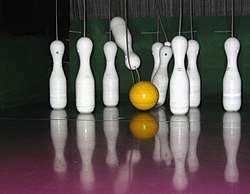Kegel (bowling)
Kegel, or kegeln, (German for "skittle", skittles) is a German bowling game, in which a player rolls a wooden or plastic ball along a smooth, hard indoor lane (German: Kegelbahn, a specially designed lane for the game).[1] The object of the game is to knock down the nine kegels at the other end of the lane. Kegel is a German derivative of European nine-pin bowling and is therefore closely related to its American counterpart, and bear similar elements to the traditional ten-pin bowling. It was also introduced to South Australia by German settlers in the 19th century and remains popular in areas in which many German people settled, such as the Barossa Valley.[2]

Description
This game is played by rolling a ball down an alley towards nine pins. Unlike the ten-pin ball — and like the ones used for other American "small-ball" bowling sports such as five-pin bowling, candlepin and duckpin — the nine-pin ball has no finger holes, although there are also special balls with two finger holes designed for novice and amateur players. The lanes are 19.5 m (64 ft) long and have no oil on them. The nine pins (literally known as "cones" in the local languages) are placed in a square shape whose diagonal coincides with the axis of the lane. In modern systems the pins are reset by a pinsetter which lifts up the pins, each connected by a string on top, and lowers them back into the square shape for the next throw. The strings can be a positive factor for the bowler, as they can knock down other pins, or a negative factor, as they can get tangled up during the resetting process, though this is not always a problem as the machine can retract the strings for a short distance and allow a few seconds for them to untangle automatically. Compared with the ten-pin "free-fall" pinsetter, the string pin-setter has fewer moving parts, consumes less power, and costs less to maintain. String pinsetters can also be found on low-cost or recreational ten-pin lanes.
The ball is 16 cm (6.3 in) in diameter and weighs approximately 2.85 kg (6.3 lb), slightly smaller than the standard ten-pin ball. For younger and/or novice players, the ball is 14 cm (5.5 in) and weigh 1.9 kg (4.2 lb), often with two finger holes. The pins usually have a weight of approximately 1.3 kg (2.9 lb).
Notes
- The Official Home Page of the Tanunda Kegel Club Archived July 7, 2011, at the Wayback Machine
- "German Traditions, Influences and Leisure Activities". Archived from the original on August 17, 2007. Retrieved June 26, 2007.
External links

- Deutscher Kegler- und Bowlingbund (DKB, German Kegel and Bowling association, in German only)
- Welcome to Kegel, Kegel Sport Pty Ltd, Coffs Harbour